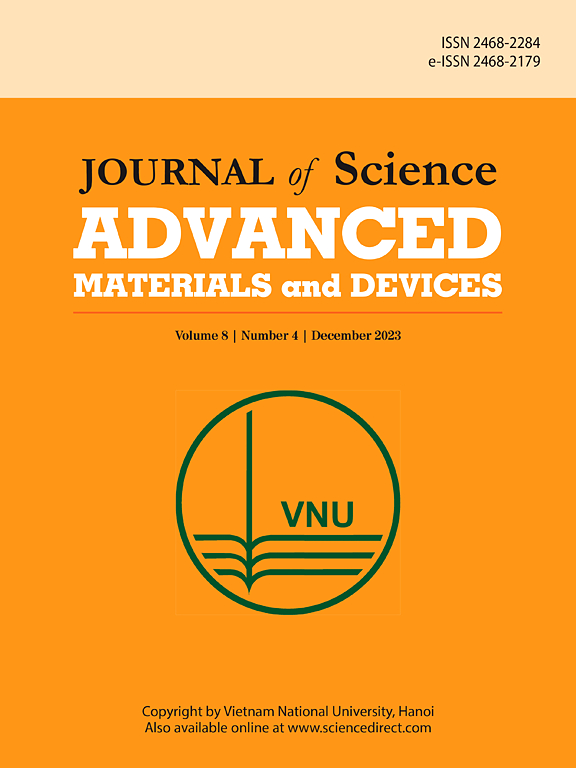Enhancement of structural, physical and tribological behaviors of newly developed Ti–25Nb–25Mo beta-type for biomedical applications
IF 6.8
3区 材料科学
Q1 MATERIALS SCIENCE, MULTIDISCIPLINARY
Journal of Science: Advanced Materials and Devices
Pub Date : 2025-07-18
DOI:10.1016/j.jsamd.2025.100952
引用次数: 0
Abstract
Titanium and its alloys continue to attract the attention of biomedical researchers due to their superior biological and mechanical biocompatibilities when compared to other metallic biomaterials. Our work aims to analyze the tribological performance of Ti-alloy with a new chemical composition (50 (at.%) Ti, 25 (at.%) Mo, 25 (at.%) Nb) and production process parameter variation (Milling time, 2, 6, 12, and 18h) effects on this behavior. The microstructure, chemical analysis, surface topography, friction, and wear characteristics of milled and consolidated Ti–Nb–Mo were thoroughly investigated using OM, SEM, EDS, laser profilometer, and tribometer with an applied load of 6 N in wet conditions using 9 g/l of NaCl. The experimental results showed that all consolidated Ti–25Nb–25Mo samples have a single β-phase due to the high [Mo]eq value of this alloy with the existence of insoluble Mo and Nb. The presence of Nb and Mo in a solid solution within the Ti-matrix can effectively improve hardness and wear resistance. In addition, it was found that as milling time extended, the average friction coefficient showed a notable rise, progressing from 0.503 at 2 h to 0.512 at 6 h and reaching the highest value of 0.564 at 12 h. Whereas the wear volume and wear rate both exhibited a similar trend of decreasing from 69.66 × 104μm3 and 110.1 × 10−4 μm3 N−1μm−1 to 27.6 × 104 μm3, 43.18 × 10−4 μm3 N−1μm−1 with increasing milling time from 2 h to 12 h, respectively. This enhancement in tribological behavior can be attributed to the improved mechanical and physical characteristics of the alloys presented by plastic deformation ability as well as the increased density with milling time to attain the highest value of 4.95 g/cm3 at 12h of milling. Furthermore, the primary mechanism of wear observed in the Ti–25Nb–25Mo system was abrasive wear, accompanied by adhesion wear and delamination.
新开发的Ti-25Nb-25Mo β型生物医学应用的结构、物理和摩擦学行为增强
与其他金属生物材料相比,钛及其合金具有优越的生物和机械生物相容性,因此一直受到生物医学研究人员的关注。我们的工作旨在分析具有新化学成分(50 (at.%) Ti, 25 (at.%) Mo, 25 (at.%) Nb)的Ti合金的摩擦学性能以及生产工艺参数变化(铣削时间,2,6,12和18h)对该行为的影响。采用OM、SEM、EDS、激光轮廓仪和摩擦计对Ti-Nb-Mo的微观结构、化学分析、表面形貌、摩擦和磨损特性进行了全面研究,并在9 g/l NaCl、6 N载荷的潮湿条件下进行了研究。实验结果表明,固结Ti-25Nb-25Mo合金由于具有较高的[Mo]eq值,且存在不溶性Mo和Nb,故所有的Ti-25Nb-25Mo试样均具有单一的β相。Nb和Mo以固溶体形式存在于ti基体中,可以有效地提高硬度和耐磨性。此外,发现磨时间延长,平均摩擦系数表现出显著的上升,发展从0.503到0.512 (2 h在6 h和达到的最高价值0.564在12 h。而磨损量和磨损率都表现出类似的趋势,减少从69.66×104μm3和110.1×10−4μm3 N−1μm−1 27.6×104μ立方米,43.18×10−4μm3 N−1μm−1随着研磨时间从2 h - 12 h,分别。这种摩擦学性能的增强可归因于合金的力学和物理特性的改善,其表现为塑性变形能力以及随铣削时间的增加而增加的密度,在铣削12h时达到4.95 g/cm3的最大值。此外,在Ti-25Nb-25Mo体系中观察到的主要磨损机制是磨粒磨损,伴随着粘附磨损和脱层。
本文章由计算机程序翻译,如有差异,请以英文原文为准。
求助全文
约1分钟内获得全文
求助全文
来源期刊

Journal of Science: Advanced Materials and Devices
Materials Science-Electronic, Optical and Magnetic Materials
CiteScore
11.90
自引率
2.50%
发文量
88
审稿时长
47 days
期刊介绍:
In 1985, the Journal of Science was founded as a platform for publishing national and international research papers across various disciplines, including natural sciences, technology, social sciences, and humanities. Over the years, the journal has experienced remarkable growth in terms of quality, size, and scope. Today, it encompasses a diverse range of publications dedicated to academic research.
Considering the rapid expansion of materials science, we are pleased to introduce the Journal of Science: Advanced Materials and Devices. This new addition to our journal series offers researchers an exciting opportunity to publish their work on all aspects of materials science and technology within the esteemed Journal of Science.
With this development, we aim to revolutionize the way research in materials science is expressed and organized, further strengthening our commitment to promoting outstanding research across various scientific and technological fields.
 求助内容:
求助内容: 应助结果提醒方式:
应助结果提醒方式:


